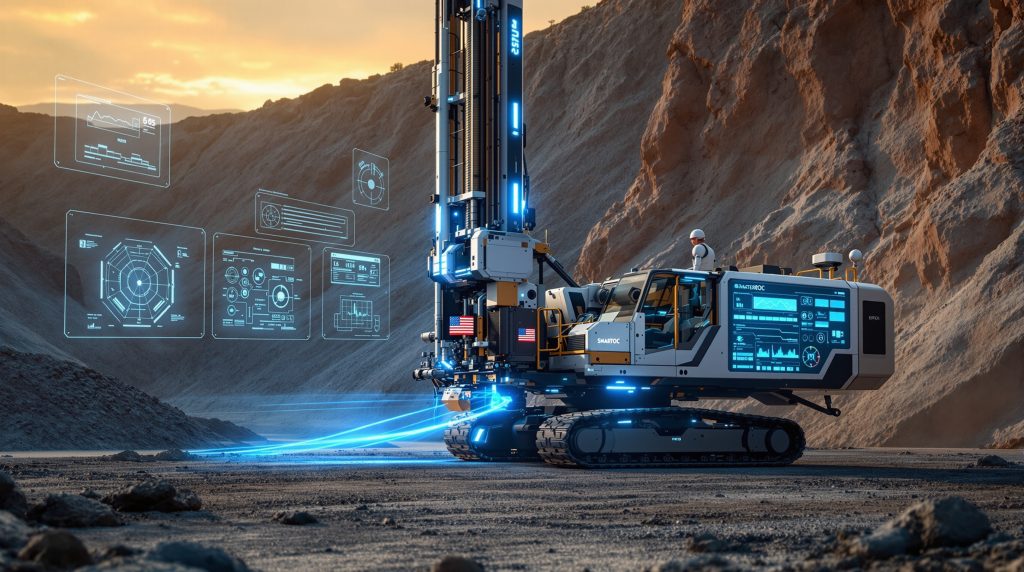Revolutionary Milestone: First Fully Autonomous Surface Drill Rig Transforms U.S. Quarry Operations
The mining and quarrying industry has entered a new era with the deployment of the first fully autonomous SmartROC D65 MKII surface drill rig in the United States. This groundbreaking technology not only represents a first for the U.S. market but also marks the first autonomous surface drill delivered specifically to the quarry sector worldwide, setting a new standard for operational efficiency, safety, and productivity.
The SmartROC D65 MKII: A Technological Breakthrough
The SmartROC D65 MKII represents the pinnacle of drilling automation technology, certified at Level 4 autonomy by the Global Mining Guidelines Group (GMG). This certification confirms the rig's ability to execute complete drilling operations independently, requiring only remote supervision rather than an operator physically present in the cab.
The autonomous capabilities extend beyond basic movement and positioning to include complete drill pattern execution, automatic rod handling, and real-time drilling parameter adjustments based on ground conditions. This adaptive functionality enables the drill to respond to varying material hardness and ground composition without human intervention.
Ron Hankins, Business Line Manager at Epiroc USA, emphasizes that this deployment represents practical implementation rather than merely experimental technology: "This partnership is not about a proof-of-concept, it's about meaningful operational gains that the next generation of drilling will bring in the US."
The Strategic Partnership Driving Innovation
The successful deployment stems from a strategic collaboration between Epiroc, a leading mining equipment manufacturer, and Luck Stone, an innovative aggregate producer known for embracing cutting-edge technologies. This partnership builds on Luck Stone's previous experience with autonomous plants and haulage systems, further cementing their position as industry pioneers.
James River Equipment, the local Epiroc dealer, provides crucial ongoing support, including maintenance services, technical assistance, and training programs that ensure the long-term viability of the autonomous drilling operations. This three-way partnership model combines global technology expertise with local implementation knowledge and customer-focused innovation.
Chuck Stilson, Senior Director of Engineering at Luck Stone, highlights how the company views this technology: "Our philosophy has always been about doing the work in the best possible way. Partnering with Epiroc on autonomous drilling aligns perfectly with that vision. We're not only improving productivity and safety, we're providing new opportunities for our associates and rethinking what's possible in aggregates."
How Full Autonomy Transforms Quarry Operations
The introduction of fully autonomous drilling technology fundamentally changes multiple aspects of quarry operations, from safety protocols to productivity metrics and workforce dynamics.
Enhanced Safety Through Operator Removal
Safety improvements represent one of the most significant benefits of autonomous drilling technology. By removing operators from the immediate drilling environment, companies eliminate exposure to multiple hazards including:
- Dust inhalation and respiratory risks
- Noise-induced hearing damage
- Whole-body vibration injuries
- Rock fall dangers
- Equipment-related accidents
- Weather exposure risks
The autonomous system also maintains consistent safety protocols throughout operations, eliminating human factors like fatigue, distraction, or procedural variations that can contribute to accidents in conventional drilling.
Operational Efficiency Gains
Autonomous drilling delivers substantial efficiency improvements through several key mechanisms:
- Continuous operation beyond traditional shift limitations
- Elimination of shift changes and operator breaks
- Consistent drilling performance regardless of time of day
- Precise hole positioning with minimal deviation
- Optimized drilling parameters based on real-time ground condition analysis
- Reduced non-productive time between holes
These efficiency improvements typically translate to increased production capacity without expanding equipment fleets, providing a competitive advantage in the high-volume, low-margin aggregate business.
Addressing Labor Market Challenges
The quarrying industry faces persistent challenges in recruiting and retaining skilled equipment operators, particularly in rural locations where many operations are situated. Autonomous drilling technology helps address these challenges by:
- Reducing overall labor requirements for drilling operations
- Creating higher-skilled technical positions that attract technology-oriented workers
- Allowing centralized supervision of multiple machines from comfortable environments
- Enabling knowledge workers to focus on optimization rather than repetitive tasks
- Providing career advancement opportunities through technical specialization
This workforce transformation comes at a crucial time when many experienced operators are reaching retirement age, and fewer young workers are entering traditional mining industry evolution and quarrying roles.
What Technology Makes Autonomous Drilling Possible?
The autonomous SmartROC D65 MKII relies on multiple integrated technologies to achieve its full autonomy capabilities. Understanding these systems helps explain how the technology can be implemented in various quarry environments.
Common Automation Panel (CAP) System
The CAP system serves as the primary interface between human supervisors and autonomous equipment. Key features include:
- Intuitive touchscreen interface with real-time operation visualization
- Remote monitoring of drilling parameters including penetration rate, pressure, and depth
- Intervention capabilities for unusual situations requiring human judgment
- Performance analytics dashboards showing productivity metrics
- Maintenance status indicators and diagnostic tools
- Multiple rig management from a single station
This system enables a single technical supervisor to oversee multiple drilling operations simultaneously, dramatically improving workforce productivity while maintaining operational oversight.
Link Open Autonomy (LinkOA) Platform
The LinkOA platform provides the critical data infrastructure supporting autonomous operations across sites. This platform:
- Integrates with existing fleet management and production planning systems
- Enables seamless data flow between equipment, operators, and management systems
- Supports standardized communication protocols for multi-vendor equipment compatibility
- Provides open architecture for future technology integration
- Delivers comprehensive performance tracking and analytics
- Facilitates remote technical support and troubleshooting
This platform approach means the autonomous drilling system doesn't operate in isolation but becomes part of the quarry's broader digital ecosystem, enhancing overall operational intelligence.
Advanced Navigation and Drilling Automation
At the equipment level, several specialized technologies enable autonomous navigation and drilling:
- High-precision GPS and inertial guidance systems for position accuracy
- Advanced obstacle detection sensors preventing collisions
- Automated drill rod handling systems for continuous operation
- Self-adjusting drilling parameters responding to material variations
- Automatic hole depth measurement ensuring pattern compliance
- Self-diagnostic capabilities identifying maintenance needs
These technologies work in concert to replicate and enhance the functions previously performed by skilled human operators while adding new capabilities beyond human performance limits.
Why is the U.S. Aggregate Market Significant for Autonomous Technology?
The deployment of autonomous drilling technology in the U.S. aggregate market represents a strategically important milestone for several compelling reasons.
Market Scale and Economic Impact
The United States represents the world's largest aggregate market, producing approximately 2.5 billion tons of crushed stone, sand, and gravel annually. This massive production volume creates economic conditions that favor technological innovation:
- High-volume operations benefit disproportionately from incremental efficiency gains
- Competitive pressure in commodity markets drives cost optimization
- Scale economies support investment in advanced technologies
- Widespread distribution of operations enables rapid knowledge transfer
- Market leadership position influences global industry standards
The size and sophistication of the U.S. market make it an ideal proving ground for technologies that may subsequently be deployed globally.
Technology Transfer from Mining to Quarrying
The autonomous SmartROC D65 MKII represents a significant technology transfer from large-scale mining to quarrying operations. This crossover is noteworthy because:
- Mining operations typically have higher margins supporting innovation investment
- Quarries operate at smaller scales requiring more cost-effective implementations
- Mining automation systems often require adaptation for quarry environments
- Successful quarry deployments demonstrate scalability across operation sizes
- The technology platform approach enables customization for different applications
This technology transfer pathway often accelerates adoption by reducing development costs and leveraging proven solutions from adjacent industries.
Regulatory and Standardization Leadership
The U.S. market also plays an important role in establishing regulatory frameworks and industry standards for autonomous equipment. The successful deployment of the first fully autonomous SmartROC D65 drill rig in US:
- Demonstrates compliance with existing safety regulations
- Provides case studies for regulatory agencies developing future guidelines
- Influences international standards development
- Establishes precedent for insurance and risk management approaches
- Creates reference implementations for industry-wide best practices
These regulatory considerations are particularly important for autonomous technology, where standards are still evolving alongside the technology itself.
What Long-Term Impact Will Autonomous Drilling Have?
The introduction of fully autonomous drilling represents more than an incremental improvement—it signals a fundamental transformation in how quarries operate and how the aggregate industry will evolve over the coming decades.
Workforce Evolution and New Career Paths
The transition to autonomous drilling creates significant workforce changes that extend beyond simply reducing operator headcount:
- Operators evolve into technical supervisors managing multiple machines
- New roles emerge in data-driven operations and autonomous system management
- IT capabilities become increasingly central to quarry operations
- Technical training programs develop to support skill transitions
- Educational partnerships form with community colleges and technical schools
- Career progression paths shift toward technology specialization
This workforce transformation requires proactive management but ultimately creates more sustainable and attractive career options that will help the industry attract diverse talent.
Operational Excellence Through Consistency
Autonomous drilling delivers unprecedented consistency in drilling operations, which cascades into improvements throughout the production process:
- Precise hole placement improves blast fragmentation consistency
- Consistent fragmentation reduces secondary breaking requirements
- Uniform muck piles enable more efficient loading operations
- Predictable material sizing improves crushing and screening efficiency
- Reduced variation enables tighter process control throughout production
- Data-driven decision making replaces experience-based judgment
These consistency improvements often deliver greater overall value than the direct productivity gains from automation alone, as they optimize entire production chains rather than isolated operations.
Knowledge Sharing and Industry Advancement
Both Epiroc and Luck Stone have committed to sharing performance data following the implementation period, which will accelerate industry-wide learning and technology adoption. This collaborative approach:
- Establishes performance benchmarks for autonomous drilling
- Identifies best practices for implementation and operation
- Quantifies benefits across different operational contexts
- Guides future development priorities based on field experience
- Builds collective knowledge benefiting the broader industry
This commitment to knowledge sharing reflects a recognition that autonomous technology represents a transformative shift requiring industry-wide cooperation rather than purely competitive advantage.
How Can Quarry Operations Prepare for Autonomous Technology?
As autonomous drilling technology demonstrates its value, more quarry operations will consider adoption. Preparing for this transition requires careful planning across multiple dimensions.
Infrastructure and Technical Requirements
Successful implementation of autonomous drilling requires specific site infrastructure and technical capabilities:
- Robust wireless communication networks with site-wide coverage
- High-accuracy site mapping and digital terrain models
- Dedicated autonomous operation zones with appropriate safety barriers
- Remote monitoring facilities with reliable connectivity
- Integration capabilities with existing production management systems
- IT security protocols for protecting operational technology
These infrastructure requirements often represent significant investments beyond the equipment itself and must be factored into modern mine planning and return-on-investment calculations.
Phased Implementation Strategies
Most successful autonomous technology deployments follow a phased approach that manages change effectively:
- Initial site assessment identifying high-value application areas
- Technology readiness evaluation of existing systems and infrastructure
- Operator assistance features implemented before full autonomy
- Pilot programs in controlled areas before site-wide deployment
- Gradual expansion as experience and confidence develop
- Performance benchmarking at each implementation stage
This phased approach reduces implementation risk while allowing operations to capture incremental benefits throughout the transition process.
Personnel Preparation and Change Management
The human aspects of autonomous technology implementation often present greater challenges than the technical components:
- Early engagement with workforce about automation plans and timeline
- Transparent communication about role changes and opportunities
- Skills assessment identifying candidates for technical roles
- Training programs developing both technical and supervisory capabilities
- Knowledge transfer from equipment manufacturers to site personnel
- Recognition programs celebrating adaptation and new skill development
Effective change management strategies recognize that autonomous technology represents a significant cultural shift for operations that have traditionally valued operator skill and experience.
What Does the Future Hold for Autonomous Quarry Operations?
The autonomous SmartROC D65 MKII represents just the beginning of a broader transformation in quarry operations. Future developments will likely extend autonomy across additional equipment types and operational processes.
Integrated Autonomous Equipment Ecosystems
The full potential of autonomous technology emerges when multiple autonomous systems operate in coordination:
- Autonomous drilling integrated with autonomous loading
- Coordinated autonomous haulage systems
- Automated material sampling and quality control
- Integrated production planning optimizing equipment coordination
- Centralized control systems managing entire autonomous fleets
- Seamless handoffs between autonomous process stages
This integrated approach transforms isolated autonomous machines into comprehensive autonomous operations with significantly higher productivity potential.
Advanced Analytics and Machine Learning Applications
As autonomous systems generate vast operational data, advanced analytics and machine learning applications will extract additional value:
- Predictive maintenance models preventing equipment failures
- Ground condition mapping optimizing AI drilling innovation
- Production optimization algorithms maximizing throughput
- Energy usage optimization reducing operational costs
- Real-time quality prediction enabling process adjustments
- Digital twins facilitating scenario planning and simulation
These data-driven applications represent a secondary wave of benefits beyond the initial automation advantages, creating continuous improvement potential.
Environmental and Sustainability Enhancements
Autonomous drilling technology also contributes to environmental performance improvements:
- Optimized drilling parameters reducing energy consumption
- Precise hole placement minimizing explosive requirements
- Reduced material waste through consistent fragmentation
- Lower emissions from optimized equipment utilization
- Decreased noise and dust through technical optimization
- Enhanced site rehabilitation through accurate execution
These environmental benefits align with increasing sustainability expectations from communities, regulators, and customers, creating additional value beyond operational efficiency.
Understanding Autonomous Drilling: Key Questions Answered
What level of autonomy does the SmartROC D65 MKII achieve?
The SmartROC D65 MKII operates at Level 4 autonomy according to the Global Mining Guidelines Group (GMG) standards. At this level, the equipment can execute complete drill patterns without an operator in the cab, requiring only remote supervision through the Common Automation Panel system. The machine autonomously navigates between holes, positions accurately, performs drilling operations, and handles drill rods without direct human intervention.
How does autonomous drilling compare to traditional methods in productivity?
Autonomous drilling typically delivers 15-20% productivity improvements over conventional operations through several mechanisms. The system eliminates operator breaks and shift changes, maintains consistent performance throughout operating periods, optimizes drilling parameters in real-time based on ground conditions, and minimizes time between holes. These efficiency gains compound over time, particularly in 24/7 operations where human factors like fatigue become significant.
What safety benefits does autonomous drilling provide?
Autonomous drilling significantly enhances safety by removing operators from hazardous environments where they would be exposed to dust, noise, vibration, and equipment-related risks. The technology also eliminates safety incidents related to operator fatigue or procedural variations. Additionally, the predictable movement patterns of autonomous equipment reduce site-wide collision risks and create more controlled operational environments.
How quickly can quarry operations implement autonomous drilling technology?
Implementation timelines vary based on site readiness, but typically range from 6-12 months for a complete transition to autonomous drilling. This process includes site infrastructure preparation, personnel training, safety system implementation, and phased deployment starting with limited operational areas. Operations with existing digital infrastructure and experience with semi-autonomous systems can achieve faster implementations, while those starting from conventional operations may require longer transition periods.
What roles do operators play in autonomous drilling operations?
In autonomous drilling operations, traditional operators transition to remote supervisors who oversee multiple machines from a central control location. These technical supervisors monitor drilling performance, intervene when necessary for unusual situations, optimize drilling plans based on performance data, and coordinate with maintenance teams. This role requires different skills than traditional operation, combining technical understanding with data analysis capabilities and systems thinking.
How does autonomous drilling technology integrate with existing quarry systems?
The LinkOA platform enables integration between autonomous drilling systems and existing quarry management technologies including fleet management, production planning, maintenance systems, and quality control processes. This integration relies on standardized data protocols that allow information to flow seamlessly between systems from different vendors. For operations with limited existing digital infrastructure, autonomous drilling implementation often serves as a catalyst for broader digital transformation.
How to Maximize Returns from Autonomous Drilling Investment
Implementing autonomous drilling technology requires significant investment beyond the equipment itself. To maximize returns, operations should:
- Conduct thorough baseline performance measurement before implementation
- Identify specific operational pain points that autonomy can address
- Develop comprehensive implementation plans addressing technical, infrastructure, and personnel aspects
- Create clear performance metrics for measuring success
- Establish continuous improvement processes leveraging operational data
- Build internal expertise through training and knowledge transfer
- Share learnings across operations to accelerate improvement
- Consider broader operational implications beyond the drilling function
These strategic approaches ensure that autonomous drilling technology delivers its full potential value rather than simply replacing conventional equipment with more sophisticated alternatives.
Autonomous Drilling vs. Traditional Operations: Performance Comparison
| Operational Factor | Traditional Drilling | Autonomous SmartROC D65 |
|---|---|---|
| Daily Operating Hours | 16-20 hours with breaks | 22-24 hours continuous operation |
| Drill Hole Accuracy | ±10-15 cm typical | ±5 cm or better |
| Drilling Parameter Consistency | Varies between operators | Consistent across operations |
| Response to Ground Conditions | Based on operator experience | Data-driven real-time adjustment |
| Non-Productive Time | 20-30% of operating hours | 10-15% of operating hours |
| Safety Exposure | Operator present at rig | Remote supervision only |
| Data Collection | Limited manual recording | Comprehensive automated logging |
| Maintenance Approach | Schedule or failure-based | Condition-based predictive |
This performance comparison highlights the multidimensional advantages of autonomous drilling beyond simple productivity metrics, demonstrating how the technology transforms fundamental operational characteristics.
The deployment of the first fully autonomous SmartROC D65 drill rig in the U.S. quarry market represents not just an incremental improvement but a transformative milestone in how aggregate operations function. As the technology proves its value and knowledge spreads throughout the industry, autonomous drilling will likely become the new standard for operational excellence, safety, and efficiency in quarrying operations worldwide. Industry leaders can learn more about these innovations at upcoming innovation expo insights events where the latest autonomous technologies will be showcased.
Ready to Capitalise on the Next Mineral Discovery?
Stay ahead of the market with real-time alerts on significant ASX mineral discoveries through Discovery Alert's proprietary Discovery IQ model, providing actionable insights for both short-term traders and long-term investors. Explore historic returns from major discoveries and begin your 30-day free trial today at Discovery Alert's discoveries page.




